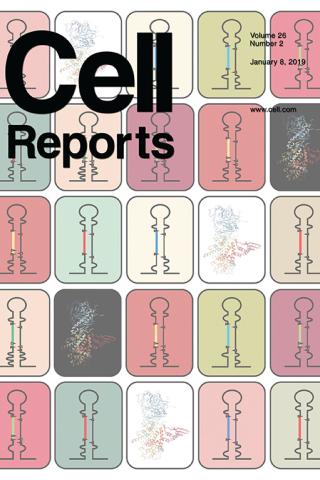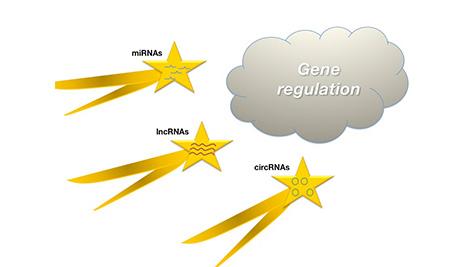
Shuo Gu, Ph.D.
- Center for Cancer Research
- National Cancer Institute
- Building 560, Room 11-83B
- Frederick, MD 21702
- 301-846-5447
- shuo.gu@nih.gov
RESEARCH SUMMARY
Dr. Gu’s research focuses on the mechanisms of RNA interference and microRNA (miRNA) pathways, and their applications in cancer treatment. miRNAs play essential roles in gene regulation and human diseases. Dysregulated miRNAs contribute to various cancers, making their regulatory mechanisms a crucial area of study. The Gu lab uses genetic studies, biochemical and structural analyses, deep sequencing, bioinformatics, and functional assays to investigate miRNA regulation in cancer. The goals are to understand miRNA function in health and disease and to develop new cancer therapeutics based on these insights.
Areas of Expertise

Shuo Gu, Ph.D.
Research
Study of miRNA Isoforms (isomiRs)
A specific focus of our research is to elucidate the mechanisms underlying sequence alterations at miRNA ends and how these alterations diversify miRNA function. A single miRNA locus can generate multiple distinct miRNA isoforms (isomiRs) that differ in length, sequence composition, or both. Depending on the site of the heterogeneity, isomiRs can be categorized into 5' and 3' isomiRs. We developed a novel algorithm that allows us to detect and annotate isomiRs from next-generation sequencing data with high confidence. Using this method, we demonstrated that isomiR profiles are cell-, tissue-, and disease-specific. By combining genetic studies with biochemical and structural approaches, we established the tertiary structure of pri-miRNAs and their specific interactions with Drosha as major determinants for 5' isomiR production. Our studies also provided insights into how 5' isomiR biogenesis is regulated in cancer. For 3' isomiRs, we discovered that uridylation can alter the way miRNAs recognize their targets, revealing unique functions of 3' isomiRs. Our findings support the hypothesis that isomiR biogenesis is tightly regulated, allowing isomiRs to play important and distinct biological roles. Current studies are focusing on uncovering novel functions of isomiRs in the context of cancer.
Regulation of miRNAs by Tailing
A unique mode of miRNA regulation is tailing, where non-templated nucleotides are added to the 3' end of pre-miRNA and mature miRNA. By examining the impact of tailing on mature miRNAs, we found that 3' uridylation can alter miRNA target recognition. We also identified the TUT-DIS3L2 machinery as a cellular surveillance system that monitors the 3' ends of AGO-bound miRNAs, with TUT uridylating exposed miRNA 3' ends, leading to degradation by the exonuclease DIS3L2. However, 3' tailing did not globally affect miRNA abundance. In contrast, tailing of pre-miRNAs regulates miRNA abundance through diverse mechanisms. TUT4 and TUT7 negatively regulate let-7 family members by oligo-uridylating their precursors in a LIN28-dependent manner. This oligo-uridylation leads to the degradation of the precursors by the nuclease DIS3L2, resulting in lower levels of mature let-7. Much remains to be understood about the broader impact of oligo-uridylation on miRNA precursors. We aim to understand why certain pre-miRNAs are preferentially uridylated and the functional consequences of pre-miRNA uridylation.
Cancer Mutations in miRNA Biogenesis Pathway Components
Despite the extensive documentation of the roles of miRNAs in tumorigenesis, the development of miRNA-based cancer treatments has lagged. This is partly due to the difficulty in identifying tumor-driver miRNA variations through profiling-based approaches. To address this challenge, we focus on genetic evidence by studying recurrent mutations in miRNA biogenesis factors found in cancer patients. We reasoned that the resulting miRNA alterations are likely crucial to tumor formation and/or progression. Our initial focus is on DICER1 RNase IIIb mutations, which are prominent in certain pediatric cancers and are hallmarks for DICER1 syndrome-related tumors. To elucidate the functional implications of the DICER1 RNase IIIb mutation, we generated a set of cells mimicking DICER1-associated tumors using CRISPR. We found that the DICER1 RNase IIIb hotspot mutation not only causes a loss of function for 5p-miRNAs but also leads to a gain of function for a set of 3p-miRNAs, potentially impacting DICER1 tumor pathogenicity. Our in vitro and in vivo analyses implicate strand switching by AGO as the mechanism for the functional upregulation of passenger 3p-miRNAs, a novel mode of miRNA regulation. Using a mouse model and an isogenic cell culture-based platform, we aim to identify and validate the specific requirements for miRNAs that underlie DICER1-related tumorigenesis. If successful, identifying miRNAs as druggable targets may provide new prospects for cancer therapy.
Publications
- Bibliography Link
- View Dr. Gu's Complete Bibliography at NCBI.
AGO-bound Mature miRNAs Are Oligouridylated by TUTs and Subsequently Degraded by DIS3L2
3' Uridylation Confers miRNAs with Non-canonical Target Repertories
Structural Differences between Pri-miRNA Paralogs Promote Alternative Drosha Cleavage and Expand Target Repertoires
Cytoplasmic Drosha activity generated by alternative splicing.
Biography

Shuo Gu, Ph.D.
Shuo Gu received his B.A. in Tsinghua University, China. He completed his Ph.D. training in the laboratory of Dr. John Rossi at Beckman Research Institute, City of Hope, Los Angeles. Shuo Gu undertook his postdoctoral training in the laboratory of Dr. Mark Kay at Stanford University Medical School, Palo Alto. Both his Ph.D. and postdoctoral research focused on the mechanisms of RNA interference and microRNA pathways, and their applications in gene therapy. He joined the RNA Biology Laboratory (formerly the Gene Regulation and Chromosome Biology Laboratory) in 2013 as a Stadtman Investigator.
Job Vacancies
We have no open positions in our group at this time, please check back later.
To see all available positions at CCR, take a look at our Careers page. You can also subscribe to receive CCR's latest job and training opportunities in your inbox.
Team
News
FARE2023 Winners – Fellows Award for Research Excellence
Chunmei Shi, Sharan Malagobadan, Karrie Spain & James Shamul
2023 Spring Research Festival Poster Blitz - 3rd Place: Karrie Spain, NCI: “Mapping Functional microRNA Target Sites in vivo by RNA Editing”
Congratulations to Acong Yang, recipient of the 2022 NCI Director's Innovation Award.
Gene-regulating microRNAs gain control over hundreds of new genes with common sequence modification
miRNAs, lncRNAs and circRNAs are newfound types of non-coding RNAs that are shedding light on the regulation of gene expression.
Photo courtesy of the NIH IRP
MicroRNAs have an enormous influence over what happens inside cells. By blocking the activity of specific sets of genes, they help control virtually every known biological pathway and process. Disruptions in microRNAs have been linked to many diseases, and understanding how these molecules function, which genes they control and how they themselves are regulated are high priorities in cancer research.
New research from Shuo Gu, Ph.D., Investigator in the RNA Biology Laboratory, shows that when a microRNA undergoes a common modification called uridylation, its genetic targets change. A single microRNA can regulate hundreds of different genes, but when a microRNA is uridylated, the team found, even more genes come under its control.
Modifications to microRNAs that either clip off or add to their short sequences are widespread, but it has not been know what effect these modifications have on microRNA function. Until the new study, reported June 6, 2019, in Molecular Cell, there were few clues to suggest that uridylation might alter the way a microRNA interacts with its targets.
2019 CCR Excellence in Postdoctoral Transition Award
Xavier Bofill de Ros Visiting Fellow; mapping the miRNA maturation defects that lead to malignancy.
Outstanding Poster Award at the 2019 Spring Research Festival
Richard Ma (intern) - Gene Therapy Genome Editing, and Genetics
Congratulations to our Postbac Poster Day 2019 recipient
Ben Birkenfeld CRTA - Outstanding Poster Award
Congratulations to our NCI Director's Innovation Award recipients -
2020 Xavier Bofill de Ros Visiting Fellow
2018 Acong Yang Research Fellow
2017 Xavier Bofill de Ros Visiting Fellow
Covers

Structural Differences between Pri-miRNA Paralogs Promote Alternative Drosha Cleavage and Expand Target Repertoires
MicroRNA biogenesis begins with Drosha cleavage, the fidelity of which is critical for downstream processing and mature miRNA target specificity. Bofill-De Ros et al. studied the maturation of three pri-miRNAs, which encode the same mature miRNA but differ in the surrounding structure. They see altered cleavage due to distorted and flexible stem structure of one of the miRNAs and show that distortion in the stem appears to be a general mechanism for 5′ isoform generation. Image of pri-miRNA structures and Drosha created by Xavier Bofill-De Ros
Xavier Bofill-De Ros et.al., Cell Reports, Volume 26, ISSUE 2, P447-459.e4, January 08, 2019
Lab Life

2024 Summer

2024 Hiking at Sugarloaf Mountain

2023 RNA Day

2022 Hiking at Cunningham Falls State Park

2022 RNA Day

2021 Hiking at Greenbrier Park
2018 Hiking at Greenbrier Park

2018 Christmas Party

2017 Christmas Party
2015 Hiking at Sugarloaf Mountain
Gu Lab





